We all know the feeling – that nagging worry at the back of our minds about whether we’ll find a charging point just when we need one. As enthusiasts dedicated to eco-friendly travel, it’s something close to our hearts.
But fear not! The road ahead looks bright as recent findings suggest that by 2030, an impressive network of EV charging stations will be springing up across the globe. In our latest blog post, we unravel this electrifying future, examining the growth trends, potential hurdles and what this means for us all as drivers in an increasingly connected world.
So keep your spirits high; a landscape brimming with accessible energy is just over the horizon!
Key Takeaways
- By 2030, it is expected that the global network of EV charging stations will expand enormously, with a projection of 12 million charging points representing an increase of 823% from current figures.
- Major players such as Tesla and Siemens are heavily investing in this growth, alongside energy giants like BP and technology firms innovating new solutions to improve the EV charging experience.
- A shift towards both slow and fast charging options reflects evolving consumer needs, with fast-charging stations becoming more common for long-distance travel convenience.
- Overcoming challenges at battery, vehicle, and infrastructure levels is pivotal to enhance efficiency and address technology gaps within the electric vehicle market.
- The development of a national EV charging network hinges on sound economics and investment strategies, which can significantly contribute to job creation in a range of sectors linked to sustainable transportation.
Overview of the Electric Vehicle Charging Market:
The electric vehicle charging market is projected to witness significant growth by 2030, with key players driving innovation and competition in the industry. There is also a shift towards different charging segments such as slow and fast charging options, reflecting the evolving needs of electric vehicle users.
Projected growth by 2030
We’re seeing an unprecedented surge in the electric vehicle (EV) charging infrastructure, which is set to grow exponentially by 2030. Our goal to drive sustainability is fuelling this escalation, with estimates indicating a vast expansion in the number of charge points to meet the rising demand for electric vehicles.
Here’s a snapshot of the projected growth we are looking to achieve by the end of this decade:
table {
font-family: Arial, sans-serif;
border-collapse: collapse;
width: 100%;
}
td, th {
border: 1px solid #dddddd;
text-align: left;
padding: 8px;
}
th {
background-color: #f2f2f2;
}
Electric Vehicle Charging Infrastructure Growth Projection by 2030
| Year | Projected Global Charging Points | Percentage Increase |
|---|---|---|
| 2023 | 1.3 million | Baseline |
| 2025 | 2.9 million | 123% |
| 2030 | 12 million | 823% |
This table illustrates our path towards a greener future, with charging points becoming as ubiquitous as petrol stations. We’re embracing the shift, eagerly anticipating the positive environmental impact it will bring. Investing in this infrastructure now means we’re building a foundation for cleaner air, reduced carbon emissions, and a sustainable transportation ecosystem. Let’s continue to support this growth and make the switch to electric the norm, not the exception.
Key players in the market
The electric vehicle charging market is rapidly growing, driven by the demand for sustainable transportation options and green technology. Several key players are contributing to the expansion of the charging infrastructure, including:
- Leading car manufacturers such as Tesla, Nissan, and Chevrolet that are investing in developing both electric vehicles and charging solutions.
- Energy companies like BP, Shell, and Total are establishing their presence in the EV charging market by deploying fast-charging networks at their petrol stations.
- Technology giants such as Siemens, ABB, and ChargePoint are innovating new charging technologies and software solutions to enhance the EV charging experience.
- Utility companies like E.ON, Enel, and Duke Energy are collaborating with governments to build extensive charging networks and integrate renewable energy sources.
Shift in charging segments
Electric vehicle charging segments are undergoing a significant shift as the market evolves. With an increase in electric vehicle adoption, there is a growing demand for diverse charging options.
Fast charging technology is becoming more prevalent, enabling quicker and more convenient recharging. Additionally, on-the-go charging solutions are emerging to cater to the needs of busy urban environments and long-distance travel.
These changes reflect the dynamic nature of the electric vehicle charging market, showcasing advancements in infrastructure development and meeting the varying requirements of EV drivers.
As we witness this transformation in charging segments, it’s important to stay informed about these developments and be ready to embrace new technologies that will shape the future of electric vehicle transportation.
Challenges and Trends in EV Charging:
The electric vehicle charging infrastructure faces challenges in technology gaps at the battery, vehicle, and infrastructure levels. The growth of slow and fast charging options reflects the trend towards providing more accessible and efficient charging solutions for EV drivers.
Technology gaps in battery, vehicle, and infrastructure levels
Advancements in electric vehicle (EV) technology have led to an increased demand for more efficient batteries, vehicles, and charging infrastructure. These technology gaps pose challenges for the widespread adoption of EVs, impacting their performance, range, and accessibility.
Addressing these gaps is crucial for enhancing the overall EV user experience and encouraging a seamless transition towards sustainable transportation options. The development of improved battery technologies, more versatile vehicle designs, and an expanded network of fast-charging stations will contribute to overcoming these obstacles and accelerating the shift towards greener mobility solutions.
The expansion of electric vehicle charging infrastructure is essential in bridging the technology gaps within the EV market. Investing in innovative charging solutions with higher power capacity, coupled with advancements in energy storage systems and smart grid integration, will play a pivotal role in enabling convenient on-the-go charging options while minimising environmental impact.
Growth of slow and fast charging options
As we address the technology gaps in battery, vehicle, and infrastructure levels, it’s important to consider the growth of slow and fast charging options. The development of electric vehicle (EV) charging infrastructure has seen significant advancements in both slow and fast charging solutions.
Slow charging stations are essential for home or workplace installation, providing a convenient option for overnight or all-day charging. On the other hand, fast-charging stations are becoming increasingly prevalent along highways and major roads, offering quick top-ups during long journeys.
Both types of chargers play crucial roles in expanding the accessibility and convenience of EVs.
Additionally, these different options cater to various consumer needs and usage patterns. While slow chargers support daily commutes with extended downtimes at home or work locations, fast-charging facilities ensure that lengthy trips can be undertaken without concerns about reaching destinations on time.
Creating a National EV Charging Network:
Creating a National EV Charging Network requires careful consideration of economics and investment strategies to ensure widespread accessibility. Encouraging fair competition and private investment will be crucial in driving the development of charging infrastructure while also creating job opportunities in the growing sector.
Economics and investment strategies
To develop a national EV charging network, we need to focus on the economics and investment strategies. Encouraging private investment and fair competition will be crucial in driving the expansion of electric vehicle charging infrastructure.
This approach will not only attract more players to invest in the market but also create job opportunities while meeting the increasing demand for electric vehicle charging stations.
Implementing these strategies ensures that we can build a robust national EV charging network that supports clean technology and green transportation. By doing so, we can accelerate the development of electric vehicle charging infrastructure with an eye towards energy efficiency and environmental conservation.
Encouraging fair competition and private investment
To foster widespread development of electric vehicle (EV) charging infrastructure, it is essential to encourage fair competition and private investment. By creating an open playing field for various companies, we can drive innovation and ensure that the best technologies and services prevail.
This will not only benefit consumers by offering a variety of charging options but also stimulate healthy economic competition, pushing prices down and quality up. Furthermore, incentivising private investment in EV charging networks can lead to more expansive coverage across the nation, meeting the growing demand for convenient and accessible charging stations while creating job opportunities within this burgeoning industry.
In addition to providing incentives for fair competition among companies, policymakers need to promote private investment in EV Charging Networks. This strategy involves establishing transparent regulatory frameworks that safeguard investor interests while aligning with environmental goals.
Job creation opportunities
Encouraging fair competition and private investment in the electric vehicle charging market will lead to an increase in job creation opportunities. As demand for charging infrastructure grows, there will be a surge in employment across various sectors including manufacturing, installation, maintenance, and customer service.
This expansion of the workforce will not only benefit local economies but also contribute to the advancement of sustainable transportation initiatives.
Investing in a national EV charging network encourages innovative solutions and fosters collaboration among businesses, thereby driving the need for skilled professionals who can support the development and operation of these essential facilities.
Conclusion and Future of EV Charging:
As we look to the future, the impact of EV charging on the renewable energy market and upcoming global plans for a pathway to net zero emissions are essential topics to stay connected and informed about.
So, let’s dive in and explore the exciting developments in the electric vehicle charging infrastructure market together!
Impact of EV charging on renewable energy market
The growing demand for electric vehicle (EV) charging infrastructure is reshaping the renewable energy market. As more EVs hit the road, there is an increasing need for clean and sustainable electricity to power these vehicles.
This surge in demand presents a unique opportunity to further boost the adoption of renewable energy sources such as solar and wind power. The integration of EV charging with renewable energy can lead to a more environmentally friendly transportation system while reducing greenhouse gas emissions.
Furthermore, the expansion of EV charging networks could incentivise investment in additional renewable energy capacity, leading to greater utilisation of clean energy resources. This symbiotic relationship between EV charging and renewable energy marks a significant step towards achieving a greener future by decreasing our dependence on fossil fuels and advancing towards a more sustainable energy ecosystem.
Upcoming reports and plans for a global pathway to net zero emissions
Upcoming reports and plans outline the trajectory towards achieving net zero emissions on a global scale. This includes comprehensive analysis and proposals to guide countries, industries, and communities in transitioning to sustainable practices.
Key aspects such as regulatory frameworks, technological innovation, investment strategies, and international collaboration are highlighted as crucial components of these upcoming reports.
These plans for a global pathway to net zero emissions are essential for steering us towards a cleaner and more sustainable future. They provide actionable insights that can drive impactful change across various sectors, promoting the widespread adoption of renewable energy sources and low-carbon technologies – all of which are critical steps in reducing our carbon footprint while meeting growing energy demands.
The importance of staying connected and informed on EV charging developments
Staying connected and informed about EV charging developments is crucial for keeping up with the rapidly evolving landscape of electric vehicle infrastructure. Understanding the latest advancements in technology, such as fast-charging options and on-the-go charging solutions, empowers environmentally conscious individuals to make informed decisions about their transport choices.
Being aware of the expansion of the national EV charging network and the increase in charging stations helps support conservation efforts by encouraging widespread adoption of electric vehicles.
In addition, staying connected allows us to stay abreast of demand for EV charging infrastructure and its impact on renewable energy markets. This information enables us to actively participate in discussions around creating a sustainable future through access to clean transportation options.
FAQs
1. What is the growth of electric vehicle charging infrastructure about?
The growth of electric vehicle charging infrastructure involves increasing the number of charging stations and expanding the EV charging network to support more electric vehicles on the road.
2. Why do we need a national charging network for electric vehicles?
A national charging network ensures that there are enough accessible on-the-go charging options across different locations, which promotes EV adoption by eliminating range anxiety for drivers.
3. How is the technology for EV infrastructure improving?
Technology gaps in EV infrastructure are closing due to advancements such as faster chargers and better integration with renewable energy sources, enhancing the overall efficiency of electric vehicle markets.
4. What challenges exist in expanding the electric vehicle charging network?
Challenges include meeting varied demands for new station requirements, scaling up without overburdening power grids, and ensuring all regions benefit from equal expansion despite economic disparities.
5. Does an increase in electric vehicle charging stations impact EV adoption rates?
Yes, as demand grows and installation increases, having more readily available EV chargers positively influences consumers’ decisions to switch to electric vehicles knowing they have reliable places to charge.





